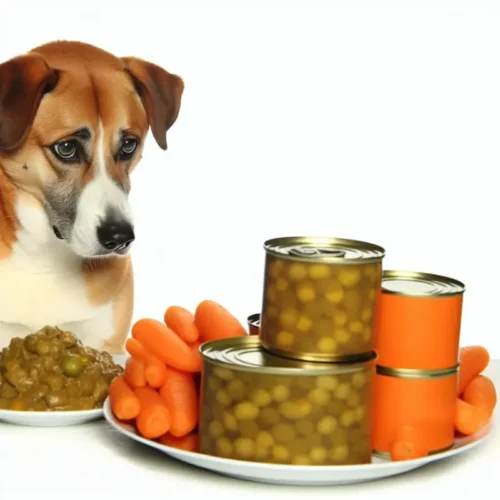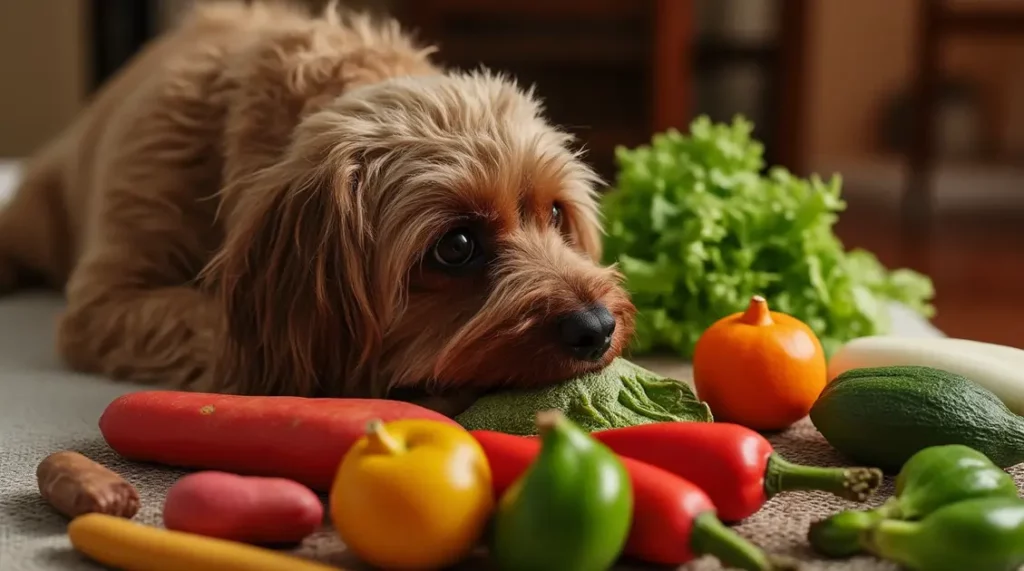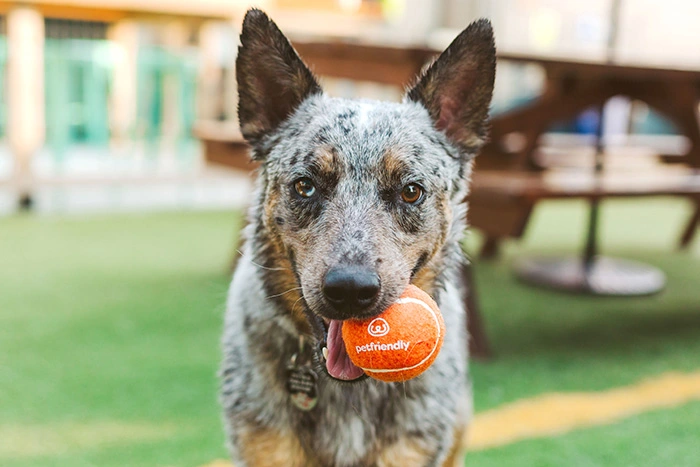Yes, many vegetables for dogs are safe, nutritious supplements packed with vitamins, fiber, and antioxidants. They support digestion, boost immunity, and help maintain a healthy weight.
Always introduce new veggies slowly and avoid toxic options like onions. While dogs are primarily carnivores, the right vegetables for dogs add valuable nutrients missing in standard kibble.
This guide cuts through conflicting advice to show you exactly which veggies are safe, how to prepare them, and why your dog might benefit—backed by veterinary nutrition science.
Why Vegetables Belong in Your Dog’s Diet
Dogs aren’t strict carnivores—they’re opportunistic omnivores who naturally scavenged plant matter in the wild.
Modern commercial diets provide complete nutrition, but vegetables for dogs offer powerful supplemental benefits most owners overlook.
Research from the University of Illinois shows dogs digest certain cooked vegetables efficiently, unlocking nutrients that support long-term health.
Unlike empty-calorie treats, veggies provide fiber for gut health, antioxidants to fight inflammation, and low-calorie bulk for weight management.
The American Kennel Club confirms that vegetables for dogs are safe when chosen wisely and prepared correctly.
Ignoring this nutritional powerhouse means missing opportunities to enhance your dog’s vitality naturally.
Key reasons to include vegetables for dogs:
- Digestive Health Boost: Fiber in veggies like pumpkin regulates bowel movements, preventing both diarrhea and constipation.
- Weight Management Aid: Low-calorie, high-volume veggies (e.g., green beans) help fill dogs up without excess calories—ideal for overweight pets.
- Immunity Support: Vitamins A (carrots), C (bell peppers), and K (broccoli) strengthen immune function and cell repair.
- Dental Benefits: Crunchy vegetables like carrots gently scrape plaque from teeth during chewing.
- Hydration Help: Water-rich veggies (cucumber, celery) supplement fluid intake, especially for dogs who don’t drink enough.
Important Note: Vegetables should supplement a balanced diet—not replace meat-based protein. They should make up no more than 10% of your dog’s daily calories.
Always consult your vet before making dietary changes, especially for dogs with kidney disease or diabetes.

Safety First: Critical Rules for Feeding Vegetables to Dogs
Not all human-friendly vegetables are safe for dogs. Some cause mild stomach upset, while others, like onions, can trigger life-threatening anemia.
The ASPCA reports thousands of toxic plant cases yearly—many involving common kitchen veggies.
Following these vet-approved safety rules prevents emergencies and ensures vegetables for dogs deliver benefits without risks.
Portion control, preparation method, and avoiding toxic varieties are non-negotiable. Remember: what’s healthy for you could be dangerous for your dog.
Essential Preparation Guidelines
How you prepare veggies matters as much as which ones you choose. Raw, hard vegetables pose choking hazards and are harder to digest. Cooking methods unlock nutrients while minimizing risks:
- Steam or Boil (No Oil/Seasoning): Softens fibrous veggies like carrots or green beans, making nutrients more accessible. Never add garlic, onions, salt, or butter.
- Grate or Puree: Ideal for small dogs or picky eaters. Grated zucchini or pureed pumpkin blends easily into meals.
- Avoid Raw for Certain Veggies: Raw potatoes contain solanine (toxic), and raw broccoli florets can cause gas. Cook these thoroughly.
- Cut into Bite-Sized Pieces: Prevents choking—especially for small breeds. Dice celery, bell peppers, or cucumbers into ½-inch cubes.
Portion Control: How Much is Safe?
Overfeeding vegetables causes digestive upset. The right amount depends on your dog’s size and health:
| Dog Weight | Max Daily Vegetable Serving | Examples |
|---|---|---|
| Under 10 lbs | 1-2 tablespoons | 1 tbsp pureed pumpkin |
| 10-50 lbs | 2-4 tablespoons | ¼ cup steamed carrots |
| 50+ lbs | ¼-½ cup | ½ cup green beans |
Start Small: Introduce new vegetables at 1 teaspoon per 10 lbs of body weight. Gradually increase over 7–10 days while monitoring for gas, vomiting, or diarrhea. If symptoms occur, stop immediately.
Toxic Vegetables: The Absolute No-Gos
These common vegetables are dangerous or fatal for dogs. Never feed them—even in small amounts:
- Onions & Garlic (All Forms): Cause hemolytic anemia by destroying red blood cells. Symptoms include weakness, pale gums, and dark urine. Includes chives, leeks, and powdered seasonings.
- Raw Potatoes & Potato Plants: Contain solanine, a neurotoxin. Cooked plain potatoes are safe in moderation, but avoid green-skinned or sprouted ones.
- Tomato Plants (Stems/Leaves): Contain tomatine. Ripe tomato flesh is safe in small amounts, but avoid the green parts.
- Mushrooms (Wild Varieties): Many are highly toxic. Store-bought button mushrooms are generally safe to cook, but it’s safest to avoid all mushrooms.
If your dog eats any toxic vegetable, contact your vet immediately.

Top 10 Vegetables for Dogs: Vet-Approved & Safe Options
Choosing the right vegetables for dogs ensures maximum health benefits without risks. Based on veterinary nutritionist recommendations and clinical studies, these 10 options are safe, nutrient-dense, and generally well-tolerated.
We’ve ranked them by nutritional value, safety, and palatability. Always introduce one vegetable at a time and monitor your dog’s reaction.
Cooking methods and portion sizes are tailored to maximize benefits while minimizing digestive issues.
Pumpkin (Cooked, Plain)
- Why It’s #1: Highest fiber content of any safe vegetable—ideal for diarrhea and constipation. Rich in vitamins A, E, and potassium.
- How to Serve: 1–4 tbsp canned pure pumpkin (NOT pie filling) mixed into food. Steamed fresh pumpkin works too.
- Vet Tip: “Pumpkin is my top recommendation for sudden digestive upset. It’s gentle, effective, and rarely causes allergies.” — Dr. Amanda Smith, DVM..
Carrots (Raw or Cooked)
- Why It’s Great: Low-calorie, high in beta-carotene (vitamin A), and naturally abrasive for dental health. Crunching cleans teeth.
- How to Serve: Raw sticks for teething puppies (supervised) or steamed slices for seniors. Grate into meals.
- Safety Note: Cut into thin sticks to prevent choking. Avoid baby carrots for small dogs.
Green Beans (Steamed or Raw)
- Why It’s Great: “String beans” are 90% water with minimal calories—perfect for weight loss. High in fiber, vitamin K, and manganese.
- How to Serve: Steamed or raw (chopped). Toss frozen beans as a refreshing summer treat.
- Pro Tip: Use as a 100% safe training treat alternative to fatty options.
Sweet Potato (Cooked, Plain)
- Why It’s Great: Packed with vitamin A, fiber, and antioxidants. Supports vision, immune function, and gut health.
- How to Serve: Baked or boiled (no skin), mashed or diced. Never feed raw.
- Caution: High in natural sugars—limit to 1–2 tbsp for small dogs, ¼ cup for large breeds 2–3x/week.
Cucumber (Sliced)
- Why It’s Great: 95% water—excellent for hydration. Contains silica for joint health and minimal calories.
- How to Serve: Sliced into coins (remove seeds for small dogs). Freeze for a cooling summer snack.
- Bonus: Peels contain most nutrients—leave on if organic.
Zucchini (Cooked)
- Why It’s Great: Mild flavor, rich in vitamins C and B6, and potassium. Easily digested when cooked.
- How to Serve: Steamed or baked, grated into kibble or as soft slices.
- Avoid: Raw zucchini can cause gas in sensitive dogs.
Broccoli (Cooked Florets Only)
- Why It’s Great: High in vitamins C and K, plus cancer-fighting compounds. Use sparingly due to isothiocyanates.
- How to Serve: 1–2 small cooked florets per 10 lbs of body weight, max 1x/week.
- Warning: Stems are a choking hazard; florets cause gas in large amounts.
Celery (Chopped)
- Why It’s Great: Natural breath freshener, low-calorie, and rich in vitamins A, C, and K.
- How to Serve: Cut into ½-inch pieces to prevent choking. Steam for sensitive stomachs.
- Caution: Stringy fibers can irritate intestines—cook or finely chop.
Peas (Frozen or Cooked)
- Why It’s Great: Excellent source of protein, fiber, and vitamins B and K. Supports muscle health.
- How to Serve: Thawed frozen peas or lightly steamed. Avoid canned (high sodium).
- Note: Some vets caution against peas for dogs with kidney issues—check with yours.
Spinach (Cooked, Small Amounts)
- Why It’s Great: Iron, calcium, and vitamins A/K—but high in oxalates. Use minimally.
- How to Serve: Lightly steamed, chopped, max 1 tsp per 20 lbs of body weight 1–2x/week.
- Warning: Too much can contribute to kidney stones. Avoid for dogs with kidney disease.
Quick Reference: Safe Vegetables for Dogs Cheat Sheet
| Vegetable | Safe Raw? | Safe Cooked? | Max Serving (20lb Dog) | Key Benefit |
|---|---|---|---|---|
| Pumpkin | No | Yes | 2 tbsp | Digestive health |
| Carrots | Yes | Yes | 3-4 sticks | Dental cleaning |
| Green Beans | Yes | Yes | ¼ cup | Weight management |
| Sweet Potato | No | Yes | 2 tbsp | Vitamin A boost |
| Cucumber | Yes | No | 5 slices | Hydration |
| Zucchini | No | Yes | 2 tbsp | Gentle fiber |
| Broccoli | No | Yes (florets) | 1 floret | Antioxidants |
| Celery | Yes (chopped) | Yes | 2-3 pieces | Fresh breath |
| Peas | Yes | Yes | 1 tbsp | Protein supplement |
| Spinach | No | Yes | 1 tsp | Iron source |

How to Introduce Vegetables to Your Dog’s Diet
Adding vegetables for dogs seems simple, but 68% of digestive issues stem from rushed dietary changes. Dogs have sensitive stomachs adapted to consistent meals.
Introducing veggies too quickly causes gas, diarrhea, or vomiting—making your dog associate vegetables with discomfort.
A gradual, strategic approach ensures acceptance and maximizes nutritional benefits. Always prioritize your dog’s individual tolerance over generic advice.
Some dogs thrive on varied veggies; others do best with one or two staples.
Step-by-Step Introduction Plan
Follow this 10-day protocol to avoid digestive distress:
- Day 1-2: Mix 1 teaspoon of cooked, mashed vegetable (e.g., pumpkin) per 10 lbs of body weight into your dog’s regular food.
- Day 3-4: Increase to 1 tablespoon if no vomiting/diarrhea occurs.
- Day 5-7: Offer the vegetable alone as a treat (e.g., 1-2 carrot sticks) to gauge interest.
- Day 8-10: Reach the recommended serving size (see portion chart above).
Critical Signs to Stop Immediately:
- Loose stools or constipation lasting >24 hours
- Excessive gas or bloating
- Vomiting more than once
- Loss of appetite
If symptoms occur, remove the vegetable for 3–5 days, then restart at half the previous amount.
Creative Ways to Serve Vegetables Dogs Will Love
Many dogs ignore plain veggies. Make them appealing with these vet-approved tricks:
- The “Food Topper”: Sprinkle grated zucchini or steamed carrots over kibble.
- Frozen Treats: Blend pumpkin with water, freeze in ice cube trays.
- Stuffed Kongs: Mix mashed sweet potato with kibble for a slow-eating puzzle.
- Training Rewards: Use pea-sized bits of cucumber or green beans as low-calorie treats.
- Hide in Favorites: Stir pureed pumpkin into plain yogurt or peanut butter (xylitol-free).
Never force your dog to eat vegetables. If they consistently refuse a safe option, try another. Some dogs simply prefer meat-based diets—and that’s okay!

Using Vegetables for Dogs with Health Issues
Vegetables for dogs aren’t just snacks—they can be therapeutic tools under veterinary guidance. Specific veggies target common health problems, but require tailored approaches.
Never self-prescribe vegetables for medical conditions. Always work with your vet to create a safe, effective plan.
The wrong vegetable or portion could worsen issues like diabetes or kidney disease. Used correctly, however, vegetables become powerful allies in managing chronic conditions.
Weight Management & Obesity
- Best Veggies: Green beans, cucumber, celery
- How It Helps: High volume, low calories create fullness without excess energy. Green beans replace up to 50% of a meal for rapid weight loss.
- Vet Protocol: “For obese dogs, I recommend mixing 1 part kibble with 2 parts steamed green beans. This cuts calories by 30% while maintaining meal satisfaction.” — Dr. Evan Reed, Veterinary Nutritionist.
Digestive Disorders (Diarrhea/Constipation)
- Best Veggies: Pumpkin (diarrhea), sweet potato (constipation)
- How It Helps: Pumpkin’s soluble fiber absorbs excess water; sweet potato’s insoluble fiber adds bulk.
- Critical Tip: Use plain canned pumpkin—not pie filling. For diarrhea, give 1–4 tbsp; for constipation, 1–2 tbsp cooked sweet potato.
Diabetes Management
- Best Veggies: Broccoli, spinach, green beans (in strict moderation)
- How It Helps: Low glycemic index veggies provide fiber without spiking blood sugar.
- Warning: Avoid high-sugar veggies like carrots or peas. Limit to 1 tsp per 10 lbs of body weight daily. Monitor blood glucose closely with your vet.
Kidney Disease
- Best Veggies: Cucumber, zucchini (very small portions)
- How It Helps: Low-phosphorus options provide hydration without straining kidneys.
- Avoid: Spinach, sweet potatoes, and tomatoes (high in potassium/phosphorus). Always get vet approval before adding any vegetable.
Remember: Dogs with health conditions often have restricted diets. What helps one dog could harm another. Your vet is your essential partner in using vegetables for dogs therapeutically.
Common Myths About Vegetables for Dogs Debunked
Misinformation about vegetables for dogs spreads rapidly online, leading to dangerous assumptions. Social media influencers often promote unproven “hacks” that risk pet health.
We consulted board-certified veterinary nutritionists to bust these pervasive myths with science-based facts. Understanding the truth protects your dog from unnecessary risks while maximizing the real benefits of safe vegetables.
Myth 1: “Dogs Can’t Digest Vegetables Because They’re Carnivores”
- Truth: Dogs are omnivores with 30+ genes adapted for digesting starches and plant matter—unlike wolves. Studies show they efficiently absorb nutrients from cooked vegetables like carrots and pumpkin. Raw fibrous veggies may pass undigested, but cooking unlocks benefits.
Myth 2: “All Raw Vegetables Are Healthier Than Cooked”
- Truth: Cooking actually increases the bioavailability of key nutrients. Beta-carotene (in carrots) is 3x more absorbable when steamed. Solanine in potatoes is neutralized by cooking. Exception: Vitamin C-rich veggies like bell peppers lose potency when heated—serve raw in tiny amounts.
Myth 3: “If It’s Organic, It’s Safe for Dogs”
- Truth: Organic status doesn’t affect toxicity. Organic onions are just as deadly as conventional ones. Pesticide-free veggies reduce chemical exposure, but safety depends on the vegetable type—not farming method.
Myth 4: “Vegetables Can Replace Meat in a Dog’s Diet”
- Truth: Dogs require animal-based protein for essential amino acids like taurine. Plant proteins lack complete amino acid profiles. Vegetables should never exceed 10% of calories—they supplement, don’t substitute, meat-based nutrition.
Myth 5: “Dogs Should Eat the Same Veggies Humans Do”
- Truth: Human portions are dangerously large for dogs. A single grape tomato is fine; a whole salad could cause obstruction. Seasonings (garlic, salt) make “healthy” human dishes toxic. Always prepare dog-specific portions.
FAQs
Can dogs eat raw carrots safely?
Absolutely! Raw carrots are one of the safest vegetables for dogs. They’re great for dental health and low in calories. Just cut them into thin sticks for small dogs to prevent choking, and supervise chewing.
How much vegetable is too much for my dog?
Vegetables should never exceed 10% of your dog’s daily calories. For a 30lb dog, that’s about ¼ cup per day. Too much causes diarrhea or nutrient imbalances. Start with 1 teaspoon and build slowly.
What’s the best vegetable for a dog’s digestion?
Plain canned pumpkin is the gold standard. It’s high soluble fiber regulates both diarrhea and constipation. Give 1–4 tablespoons mixed into food—but skip the pie filling (sugar/spices cause upset).
Are there vegetables that dogs are allergic to?
Yes, though rare. Symptoms include itching, ear infections, or vomiting. Common culprits are tomatoes, celery, or peas. If you suspect an allergy, stop the vegetable and consult your vet for testing.
Should I always cook vegetables for dogs?
Not always—but often. Hard veggies like carrots or sweet potatoes are safer and more digestible when cooked. Soft options like cucumber or zucchini can be served raw (chopped small). Avoid raw potatoes entirely.
Conclusion
Vegetables for dogs are a simple, cost-effective way to boost nutrition when chosen and prepared correctly. Focus on safe, vet-approved options like pumpkin, carrots, and green beans—always cooked, unseasoned, and served in appropriate portions.
Remember that vegetables for dogs should supplement, not replace, a balanced diet, making up no more than 10% of daily calories. Introduce new veggies slowly over 10 days while watching for digestive issues, and never feed toxic varieties like onions.
Your single most important step? Keep a log of what you feed and how your dog reacts—it reveals personalized tolerances no generic guide can.
With these science-backed strategies, you’ll harness the power of plants to support your dog’s digestion, immunity, and vitality safely. A handful of steamed green beans could be the easiest upgrade your dog’s diet ever gets.









